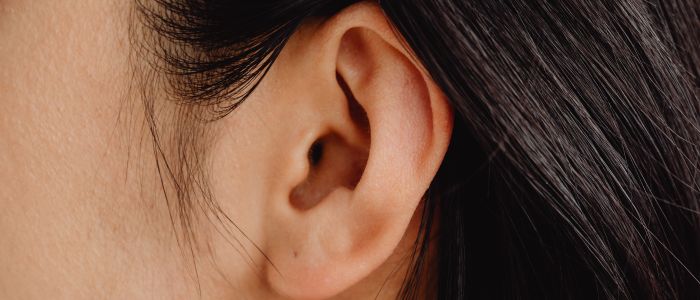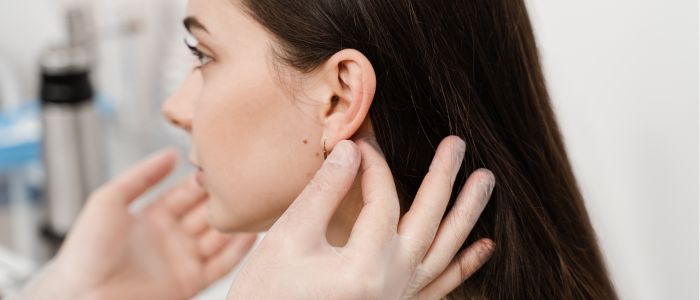
Table of Contents
- Protruding Ears: Causes, Treatments, and Considerations
- What Causes Ears to Protrude?
- Non-Surgical Treatment Options
- Surgical Options: Otoplasty
- Pinning Technique
- Scoring Technique
- Suture Techniques
- Considerations for Otoplasty
- The Best Age for Otoplasty
- Consultation and Surgery for Prominent Ears
- Cost and Insurance Considerations
- FAQs about Treatments and Solutions for Prominent Ears
- Further Reading about Procedures at Cheshire Cosmetic Surgery
Protruding Ears: Causes, Treatments, and Considerations
If you’re one of the 1-2% of people in Europe whose ears stick out more than usual, you might sometimes feel a bit uncomfortable or self-conscious about it. It’s pretty common and for most folks, it’s just a part of who they are. But if it bothers you, there are ways to address it.
Now, having ears that stick out doesn’t affect your hearing or health. It’s purely a cosmetic thing. However, if you feel like it’s affecting how you feel about yourself or how you interact with others, that’s completely valid. The good thing is that there are both non-surgical and surgical options available if you decide you want to change their appearance. Plus, understanding the condition can make a big difference in how you feel about it.
In this blog, Consultant Plastic, Reconstructive and Aesthetic Surgeon Anca Breahna covers everything you need to know about overly prominent ears, including the reasons they occur and the full range of treatments available, from simple at-home methods to professional medical procedures.
What Causes Ears to Protrude?
The formation of protruding ears primarily stems from genetic factors. As you developed in the womb, the cartilage in your ears may not have folded inward as much as it typically does for most people. This lack of folding is what causes the ears to stick out from the sides of the head. It’s a common variation and is not associated with any issues in hearing ability.
Non-Surgical Treatment Options
For many parents, the prospect of addressing protruding ears in their infants can be approached effectively without the need for surgery. Early intervention plays a key role in this process, particularly through non-surgical methods that are both safe and effective for young children. Here’s a breakdown of the most common non-surgical treatments available:
Ear Moulding Techniques
This is ideally started within the first few weeks after birth. The ear cartilage in new-borns is extremely soft due to higher levels of circulating maternal hormones and responds well to moulding. This technique involves the use of soft braces or splints that gently guide the developing cartilage into a more typical shape. The success rate of this method is quite high, provided it’s initiated early, generally within the first six weeks of life.
Soft Braces
These are custom-designed for the individual infant’s ears and are typically worn continuously for a few weeks. The braces are not painful and are usually well-tolerated by infants. Parents are trained on how to apply and care for these devices to ensure they are effective and comfortable for the baby.
Compression Headbands
If the opportunity for ear moulding has passed, which is usually around the age of six months, compression headbands are an alternative. These headbands apply gentle pressure to the ears, encouraging them to grow closer to the head. While they are less effective than direct moulding, they can still provide noticeable improvements, especially in younger children who are still in the rapid growth phase.
- Ease of use: Headbands can be worn during the day and taken off at night, or worn continuously depending on the specific product and the child’s tolerance.
- Adjustability: Many of these bands are adjustable to ensure a proper fit as the child grows.
Surgical Options: Otoplasty
When non-surgical treatments are not suitable or if you desire a more permanent solution to address protruding ears, surgical options such as otoplasty become a viable choice. Otoplasty, commonly referred to as ear pinning, is a surgical procedure that modifies the shape, position, or size of the ears through a variety of techniques. Here’s a detailed look at the techniques involved:
Pinning Technique
- Objective: The primary goal is to reshape the cartilage within the ear to enhance its natural folds and achieve a position closer to the head.
- Process: This involves making a small incision behind the ear to access the cartilage. Anca then reshapes the cartilage by creating or enhancing folds, allowing the ears to sit closer to the head.
- Outcome: This technique is effective for reducing the prominence of the ears and can significantly improve the aesthetic appearance of the ears.
Scoring Technique
- Objective: To weaken the cartilage by making precise cuts or scores, which allows it to bend towards the head.
- Process: Through small incisions, Anca scores the cartilage in strategic places to promote bending in the desired direction. This method is often used for ears that require a more substantial repositioning.
- Outcome: Scoring can offer a more dramatic correction than pinning, especially in cases where the cartilage is stiffer or the protrusion more pronounced.
Suture Techniques
- Examples: Mustardé Technique and Furnas Technique are popular suture methods used in otoplasty.
- Objective: To fold the cartilage back on itself using permanent sutures without removing any cartilage.
- Mustardé Technique: Involves placing multiple stitches through the cartilage from one side to the other, pulling the ear back towards the head.
- Furnas Technique: Sutures are used to anchor the ear cartilage to the mastoid bone behind the ear, providing a secure and lasting correction.
- Outcome: Suture techniques are less invasive and rely heavily on the strategic placement of stitches to maintain the new shape of the ear. They are effective for cases that may not require cartilage removal or extensive reshaping.
Considerations for Otoplasty
- Age and Timing: While otoplasty can be performed at any age past five years, the timing can depend on the child’s emotional and physical readiness as well as the maturity of the ear cartilage.
- Anaesthesia: Procedures are generally performed under local anaesthesia with sedation or general anaesthesia, particularly in younger children to ensure comfort and stillness during the surgery.
- Recovery: Post-operative care is crucial for successful results. Patients usually experience some discomfort and swelling, which subsides over a few weeks. Bandages are worn initially, followed by lighter dressings. Full recovery and the final outcome can be observed within a few months.
- Risks: As with any surgical procedure, there are risks such as infection, adverse reaction to anaesthesia, and the possibility of asymmetry or the need for revision surgery.
Otoplasty offers a permanent solution for altering the appearance of protruding ears, providing both cosmetic and psychological benefits. If you’re considering this option, it’s important to discuss all aspects of the surgery, including the potential risks and expected outcomes, with Anca who regularly performs ear pinning surgery.
The Best Age for Otoplasty
When considering otoplasty, or ear pinning surgery, the timing can significantly impact the effectiveness of the procedure and the comfort of the patient. Generally, it’s advised that children be at least five years old before undergoing this surgery. By this age, the ear cartilage has matured and stabilised enough to undergo correction and maintain its new shape post-surgery.
Waiting until the ear cartilage is stable is essential for achieving lasting results. If performed too early, the ongoing development of the child’s ears can negate the initial benefits of the procedure. Additionally, by the age of five, the ear has typically reached close to its full adult size, making it an ideal time for correction that will align with the child’s natural growth.
Another significant consideration for performing otoplasty around this age is the social and educational context. Starting school can be a challenging time, and children are becoming more aware of their peers and the differences among them. Unfortunately, noticeable physical differences, such as protruding ears, can sometimes lead to teasing or bullying. Addressing ear protrusion before these social challenges arise can help alleviate potential emotional distress. This can make school a more positive experience and promote a happier social interaction during these formative years.
However, otoplasty is not limited to children. Adults who feel that their ear appearance affects their social interactions or personal satisfaction can also opt for this surgery. In adult cases, the procedure is similar, but the approach may vary slightly due to the decreased pliability of adult cartilage compared to children.
Consultation and Surgery for Prominent Ears
This important meeting with Anca is where you will discuss your eligibility for the procedure, realistic expectations, and the surgical techniques that might be used, such as pinning, scoring, or suturing.
During the consultation, expect to:
- Undergo an Ear Examination: Anca assesses the structure of your ears to tailor the surgery to your specific needs.
- Discuss Techniques and Outcomes: Understand the different surgical options and what results you can expect.
- Address Concerns: Ask about the recovery process, duration of post-operative care, and any potential risks involved.
The actual surgery is performed as an outpatient procedure under local anaesthesia with sedation, taking about two hours. General anaesthesia may be used for children or according to patient preference.
Post-Surgery Care:
Recovery varies but generally involves some discomfort, swelling, and bruising initially. Bandages support the new ear position, followed by lighter dressings and possibly a night-time headband. Most patients resume normal activities within a week, with full healing taking up to six months.
Cost and Insurance Considerations
The cost of otoplasty varies but can range from £2500 to £4500 in UK, covering all associated fees. It’s often considered a cosmetic procedure, so insurance may not cover it.
FAQs about Treatments and Solutions for Prominent Ears

What are the risks associated with treatments for prominent ears?
While treatments like otoplasty are generally safe, they carry some risks, including the possibility of infection, bleeding during or after surgery, and reactions to anaesthesia. There is also a small risk of developing an asymmetrical appearance post-surgery, or less than satisfactory aesthetic results, which might require further correction.
Can prominent ears return after treatment?
In rare cases, especially if post-surgical care instructions are not followed properly, the ears might gradually shift towards their original position. However, when the surgery is performed correctly and care instructions are adhered to, results are typically permanent.
How long do non-surgical treatments take to show results?
Non-surgical treatments such as ear moulding in infants show results within a few weeks. The duration depends on the consistency of use and the child’s age when treatment begins. Compression headbands may take longer and results can vary based on how consistently they are used.
Are there age limitations for surgical treatments for prominent ears?
Surgical correction, particularly otoplasty, is recommended for children aged five years and older, as the ear cartilage is more developed and stable. However, there is no upper age limit for this surgery; adults can undergo otoplasty as long as they are in good health.
What should I consider when choosing a surgeon for otoplasty?
It is essential to choose a surgeon who specialises in plastic surgery and has extensive experience with ear surgeries. Check the surgeon’s credentials, review before-and-after photos of previous patients, and consider patient testimonials. A thorough consultation should help you feel confident in the surgeon’s ability to achieve your desired outcomes.
Medical Reference about Treatments and Solutions for Prominent Ears
- Otoplasty – NCBI: https://www.ncbi.nlm.nih.gov/books/NBK559153/
- Ear Reconstruction: Otoplasty for the Protruded Ear – PubMed: https://pubmed.ncbi.nlm.nih.gov/17667406/
- Otoplasty – Mayo Clinic: https://www.mayoclinic.org/tests-procedures/otoplasty/about/pac-20394822
- Quality of life after otoplasty for prominent ears in children – Science Direct: https://www.sciencedirect.com/science/article/abs/pii/S0165587609003327
- Otoplasty (Cosmetic Ear Surgery) – Cleveland Clinic: https://my.clevelandclinic.org/health/procedures/otoplasty
Further Reading about Procedures at Cheshire Cosmetic Surgery
- Read more about Solutions for Torn Earlobes
- Read more about Ears That Stick Out: Causes and Treatments
- Read more about Recovery after Ear Surgery
- Read more about Looking for Skin Cancer Treatment near Chester?
- Read more about Treatments and Solutions for Skin Cancer







